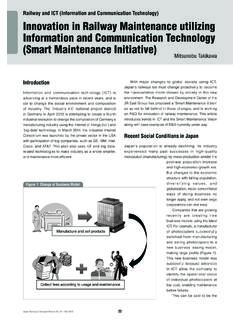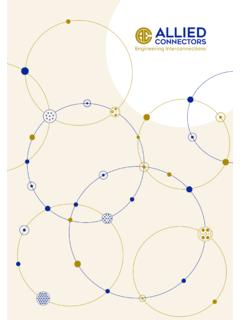Transcription of Railway Technology––The Last 50 Years and Future …
1 16 Japan Railway & Transport Review 27 June 2001 Evolution of Railway TechnologyFeatureCopyright 2001 EJRCF. All rights technology The Last50 Years and Future ProspectsRoderick A. SmithIntroductionThe beginning of a new millennium isan appropriate time to reviewdevelopments in Railway technology ,but the choice of time period for areview offers some interestingalternatives. Railway technology is oldwith roots back in the 19th century andmore than 170 Years of history sincethe opening of a developed form ofpassenger Railway between Liverpooland Manchester. In principle, thetechnology today is the same as it wasin the early days the low frictionarrangement of iron wheels on ironrails but the implementation is vastlydifferent.
2 The past 50 Years have seena greater pace of change than anyperiod since the pioneering days, so thisperiod is perhaps a suitable andmanageable period for I might start with a personalreminiscence my own earliestmemories (nearly, but not quite) 50years ago, all involve the Railway . Mygrandfather was a platelayer whobelonged to a small gang tasked withlooking after a few miles of Railway thatran a short distance in front of the housewhere I grew up. I was often taken toshare lunch with the men perhaps fishand chips salted with scrapings from ahuge pile of rock salt beside the smallhut that was their base. There wasample coal for a fire that was alwaysburning brightly and the talk was allrailways.
3 The track consisted of shortlengths of rail supported on woodensleepers held in place by woodenwedges driven between cast iron chairsand the web of the rail. The clickety-clack of the wheels passing over the railjoints was a much loved andcharacteristic feature of Railway recollections of carriages are oftheir wooden construction, separatecompartments without a corridor,bench seats that ran across the widthof the carriage and heavy leather strapsused to lower the windows in order tolean out to open the door there were fogs. Dense fogs thatreduced visibility to a couple of meters(6 ft in those days), thus rendering theoil lamp of the signals invisible to theengine drivers.
4 I was allowed to assist,in practice that meant watch, asdetonating charges were placed on theline. Enormous trains hauled bypowerful steam locomotives hurtled outof the fog exploding the detonators bytheir passage and were thus advised ofthe signal aspect by the number ofbangs. Even this small fragment ofmemory serves to remind me howmuch things have changed. Nearly allsteam engines have now gone, trackmaintenance is no longer so labourintensive, signalling has beenrevolutionalized, dense fogs are nomore (at least in England) and the linethat I remember so well has long sincebeen torn up and the land used for order to give some order to thechanges that have occurred, it isnecessary to remind ourselves of somefundamentals of the Railway .
5 Theprincipal characteristic, the now steelwheel on steel rail, has already beenmentioned. The rail provides guidance,a stiff contact and low friction thatallows large loads to be moved withlow power requirements. The sameproperties mean that braking isrelatively poor, so elaborate signallingarrangements are needed to givesufficient warning before a stop isrequired. Vehicles run on this track toform a system, used here to mean aninterdependence of the componentparts of track, signals and the glamorous part has alwaysbeen the vehicle, we should not forgetThe typical simple mechanical steam engine of 50 Years ago has been replaced by the complex mechatronic train exemplified by a Series 500 Shinkansen.
6 (Author)17 Japan Railway & Transport Review 27 June 2001 Copyright 2001 EJRCF. All rights critical role played by the track andthe huge contribution to the expensesof running a Railway eaten up by initialtrack building costs and subsequentmaintenance. Once laid, the track isgeographically inflexible, so that theshape of our railways (or system usedin the sense of extent and location), isstill largely determined by the routeslaid many Years ago back at thebeginning of the Railway of systems now and50 Years agoThe world s Railway systems nowconsist of about million route-km,carrying about trillion passenger-kmand trillion tonnes of surprisingly for those of us whohave witnessed Railway systems indecline, the total route-km of 50 yearsago is approximately the same as theroute-km today.
7 Closures in the past30 Years have been balanced bybuilding of new railways , both high-speed and freight routes. The manydifferent circumstances in variousregions and countries are summarizedin Table 1, which needs a word ofexplanation because the data aresubject to the vagaries of definition andinadequacy of collection mentioned inthe quoted sources. However, thefigures are sufficient to reveal the broadoverall trends. The function of arailway is to move either or bothpassengers or freight, so productivity ofa system is defined here as the sum ofthe passenger-km and freight-kmdivided by the route-km of the each country, the upper and lowerrows refer to data 50 Years ago and thelatest available figures, final column is the ratio ofproductivity now compared with 50years ago values greater than unityrepresenting greater is clear that some systems have grownremarkably in size, China being theprime example.
8 On the other hand, theUSA shows a more than halving ofroute. In productivity terms, all but oneof the systems has increased. The hugeincrease in Brazil deserves specialmention, being a result of the use of railfreight in developing the mineral-richMato Grosso. Closures in the USA haveresulted in great freight productivity onthe remaining routes. One third offreight in the USA moves by rail, butthe small system of Ireland (not shown)carries more passengers than closures in the UK duringthe 1960s removed many little-usedroutes, but productivity increases havebeen modest due to lack oftechnological improvements. Ofcourse, if further subdivisions are used,examples of very intensive use can beCanadaMexicoUSA Argentina Brazil France Germany Italy UK Russia/USSR S Africa China Japan India Route-kmFreight(million tone-km)Passengers(million passenger-km)
9 ProductivityRatio 1998/195069,16769,67723,33226,613360,137 170,20042,86434,05936,68126,96241,30031, 93949,81940,82621,55016,00331,33616,5361 16,900147,50020,17525,55522,20054,61627, 40127,40454,84562,725149,000304,2339,391 41,957864,0001,979,83517,3097,6598,06642 8,87338,90048,13658,20068,49010,40021,72 036,20012,292602,0003,362,20023,41195,59 139,4061,287,42033,82324,74744,163277,56 74,5321,3413,0251,79951,16119,44913,2291 0,64210,2671,53926,40055,31148,84060,514 23,57849,70032,47228,65688,000384,000n/a 9,67521,236354,261118,000395,27867,06535 7, value 1950 data from International Historical Statistics, Mitchell, BR, Europe 3rd. Ed., 1992 Africa, Asia & Oceania, 2nd Ed.
10 , 1995, The Americas, 2nd Ed., value, for various recent Years , from World Bank Railway Database, 1998 Productivity defined as (million tonne-km + million passenger- km)/route-kmTable 1 Comparison of Present Major railways with 195018 Japan Railway & Transport Review 27 June 2001 Evolution of Railway TechnologyCopyright 2001 EJRCF. All rights JR East, for example, carriesabout 6 billion passengers a year on anetwork half the size of Britain 2 amplifies this point with thesame caveats regarding data uniqueness of Japanese passengeroperations is well illustrated, but notethat in the much less densely populatedregion of the northern island ofHokkaido, the usage figure falls to amuch lower value that is typical ofsome regions of western the UK, the railways of Scotlandare very little patronized.





